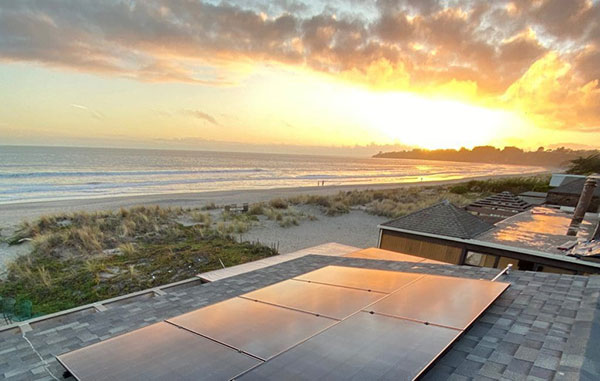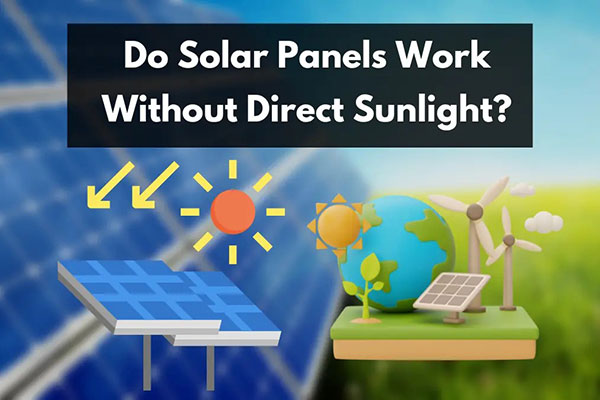Understanding Solar Panel Functionality in Various Light Conditions
Solar panels rely on light to produce energy, but their performance can highly vary, depending on the type of light they receive. While solar panels work best in ideal sunlight, they can also work on rainy days and in shaded areas. The interaction between the light and solar cells explains why this is possible.
The solar cells in a panel are what make the sunlight absorption possible. At the core of these solar cells are semiconductor materials, most often silicon.
A photon is a light particle, which, when it contacts the solar cell, it supplies it with its energy. When hit, the electrons begin moving, which creates an electrical flow. Movement of a larger number of electrons is synonymous with larger electric voltage. Maximum sunlight exposure also means that the solar cells have a bigger surface to move over.
Upon reaching the solar panel, the sunlight can vary in the number of light particles, wavelengths and intensity. Only a small part of the energy coming to the earth as sunlight is absorbed by the Newtonian color receptors.
One of the main elements that influences the efficiency of the electron movement in the solar cells is the type of the solar panel.
The solar cells in a silicon solar panel handle only about 15% of the energy that hits them. Therefore, panels operate the best in glaring, direct sunlight, meaning where no clouds are obscuring them. It is also important to promote optimal contact with light particles, which is often done by putting up solar panels at an optimal angle. In the US, this angle is between 30 and 45 degrees. Panels can rotate over the day, with their position following the movement of the sun.

Resolution of the Minimum Sunlight
It is important to begin by acknowledging the fact that despite the fact that solar panels can function in varying light conditions, there is a minimum sunlight condition. On the assumption that the solar panel will be used at its rated efficiency, the minimum sunlight condition that can be used has to at least surpass 1000 watts per square meters. Usually, such conditions are slated on the peak times of the day when the sunlight is clear.
Sunlight conditions falling below the stipulated will result in the solar panel operating at conditions below its maximum. The amount of power that can be produced at these lower levels is not nil since the panel can still generate electricity though at a lower rate. Instead of generating too little power at these conditions, it is advisable to switch off the equipment not currently being used.
The Relative Disposition of Shade
Shade has been highlighted as a challenge item to the adequacy and continued efficiency of solar panels. This is especially true of the residential environments in so far as serendipities such as trees, shrubbery, and houses tend to limit the amount of sunlight that filters into the solar panels.
This is where the aspect of cosine is introduced. The cosine of an angle between the incident light side with is proportional to the amount of light. It has been seen that as little as 10% shading of the solar panel will result in an overall 50% reduced efficiency.
Light cannot be converted into electrical energy at such low efficiencies. The cause is that since the solar panels are usually wired either in series or parallel which is the case in a majority of residential environments the shaded area produces less current. These currents are of varying power and electrical specifications resulting in the effective shutting down of the solar energy generation process.

Different Types of Inverters
In the case of shading, there are different inverter technologies to use. In general, traditional string inverters are less effective in shaded places since a panel in a string that receives a reduced amount of light decreases the performance of the whole string.
Microinverters and power optimizers are better solutions in such situations. Microinverters are installed on top of each solar panel, which means that each of the panels can operate independently. Power optimizers, in turn, are mounted on each panel from where the energy is sent to a central inverter after being optimized. The usage of these technologies guarantees that shading one of the panels will affect the overall system’s performance to a less extent.
Strategies to Implement While There Are Shaded Areas
There are several strategies to implement while installing a solar panel in a smaller shaded area. It is important to conduct a shade analysis before the installation of the panels to determine the best placement. In addition, microinverters or power optimizers can be used while there is a risk of shading to mitigate the effect.
It is preferable to avoid such a situation by putting panels in a place where it will not be shaded by other objects. Regular trimmings to clear the path of the sun are also a good solution. Another idea is to use bifacial solar panels that absorb sunlight on both sides, which can be efficient in shaded areas.
Will Solar Panels Still Be Able to Work During Overcast Weather?
Even during overcast weather, solar panels can still generate electricity. However, the amount of generated energy will be less than during sunny weather. The effectiveness of such source depends on the density of clouds and their type. For example, in the case of light clouds, the drop will be small and reach 10-20%, while with the appearance of dark clouds, the performance can drop to 80%.
Influence of cloud cover on total sunlight received on solar panel and power output: The output of a solar panel is influenced by cloud cover because where sunlight to the solar panel is blocked by the cloud and not all the sunlight would be concentrated on the solar panel. However, solar panels can still work in cloudy days because they can still collect diffused sunlight which is the sunlight that is left after the clouds and the atmosphere disperse the sunlight. In observations, where there is heavy cloud cover that there would be no sunlight that would be directed to the solar panel, in this instance the total power solar panel would power is estimated to be about 10 % to 25 % worse case scenario) of the total power that the solar panel would power in absence of the cloud cover.
It is important to note that the solar panel would anyway still be producing some current to the grid and therefore partially assisting to power equipment and reducing dependency on other grid sources.
“Cloud lensing and solar power generation:” An interesting scenario that occurs sometimes as a result of cloud cover a phenomenon known as cloud lensing. In this scenario the edge of a cloud can magnify sunlight to the point that the solar panel can receive sunlight that is more intense compared to a clear day. This can lead to a scenario where cloud cover can increase the amount of sunlight that can the solar panel and in the real essence generate more power than when there would be no cloud cover.
Ways to reduce the influence of reduced power output of solar panels: use of solar substitutes to provide power in case the sun is not shinning can provide useful insight to in minimization of the amount of energy that is lost from a solar panel.

Rain and Solar Panel Self-Cleaning
Despite the common misconception, rain can also contribute to the effectiveness of solar panels. They often get covered in dust, pollen, and other debris that could impede the effectiveness of the device by stopping sunlight.
Rainwater helps in cleaning the debris off the panel, acting as a natural cleansing agent. Solar panels are known for being effective self-cleaning devices that do not need anything but the rain to be washed.
How Solar Panels Behave Against Snow and Cold
Solar panels sometimes get buried in snow, which could lessen or stop their productivity.
Crystallized water may provide some insulation to the devices as it allows the solar panel to stay a little warmer than the outside temperature. Given that many solar panels are angled and that there is some warmth generated by the device itself, the snow covering the device would most likely slide off the panel. Lighter snow would be lured by the attractiveness of the smooth surface and stick with the surface of the glass. Snow is a negligible issue with solar devices, so is the cold – in fact, the lower temperature contributes to the advantages of solar energy by making cells even more effective.
Resistance to High Winds and Hail
Panels are entirely prepared to survive all types of extreme weather conditions, including high winds and hail. The technology is mounted on a roof or to the ground in a manner that preserves it in winds of up to 140 mph. Even though hail is never a good thing, the risks of bad weather or strong impacts are reduced to panels being hit with one-inch hailstones traveling at about 50 mph. Requirements state that only extreme instances are considered – in all other cases, the installation is sturdy enough to take usual adverse weather.


